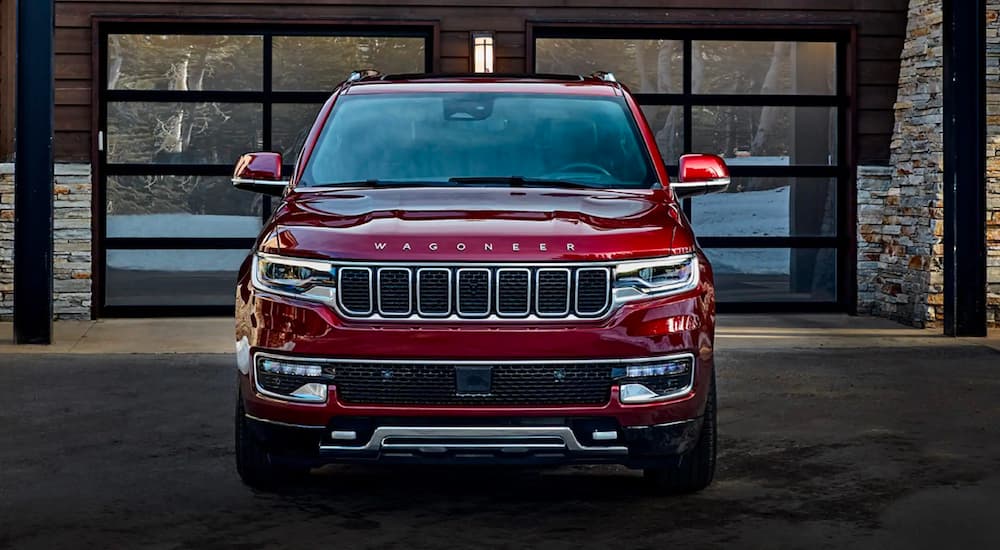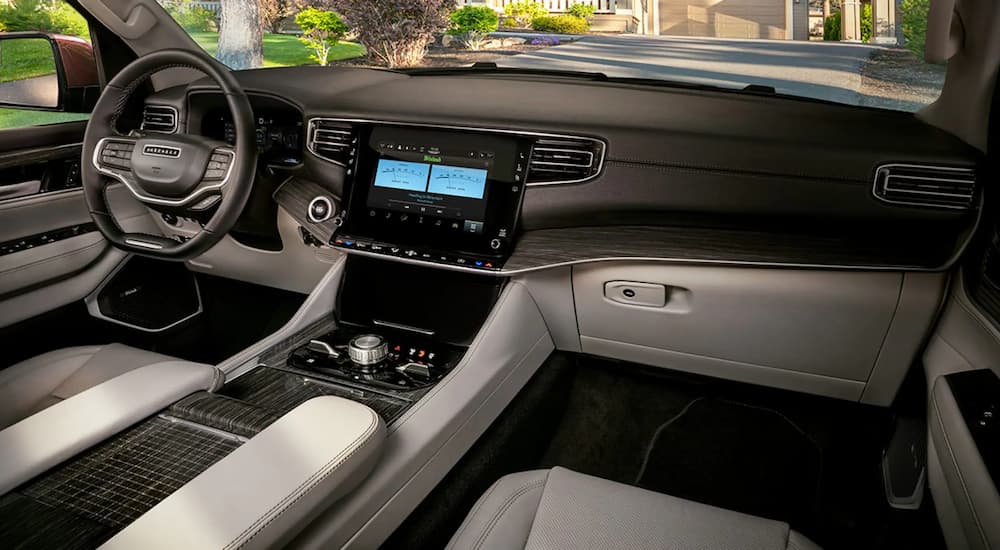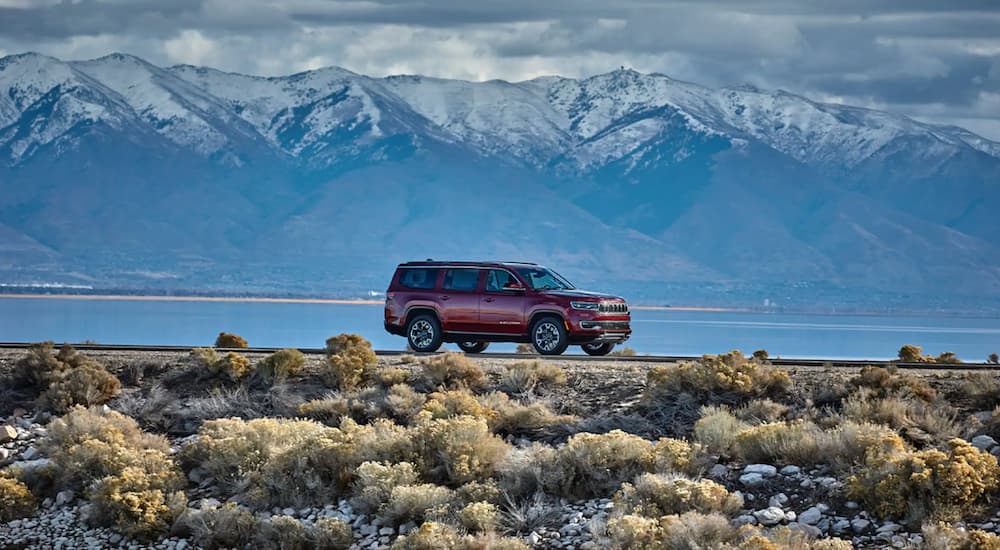Check Out Our Youtube Channel! Click Here

While the Jeep brand originated in the 1940s, it was the 1960s that brought about significant innovation to the company. It was one Jeep designer who chose to focus on designing a vehicle for family travel that could go anywhere, just like the rest of the Jeep family. As Jeeps were being driven on the other side of the world for military duties, a new Jeep designed for comfort and outdoor excursions was being developed. Here, we will share the history of the original Wagoneer to encourage appreciation for the new Wagoneer models now available at your NJ Wagoneer dealership.
The First Decade
When the first Wagoneer was designed and produced, Jeep was owned by Kaiser Jeep Corporation. The Wagoneer’s first arrival on the automotive scene was in 1963, a product of the idea that Jeep wanted to build a family-oriented vehicle. Origins of the Wagoneer erupted out of the notion that a station wagon would be the direction Jeep would take to replace an old pre-war model; however, designer Brooks Stevens took the Wagoneer toward a loftier goal of luxurious sport utility. Thus, the Wagoneer was birthed amongst its more austere brethren of the day—a marked contrast of comfortable, fashionable, and car-like drivability that made it instantly successful.
For eight years, not even the Range Rover could compete with the uniquely-designed Wagoneer, which featured amenities like power steering and brakes, a radio, and optional air conditioning. The independent front suspension contributed to less truck-like ride quality, yet it still had the chops to tow and haul like a truck, a first for four-wheel drive vehicles at the time. With the incredible response to the Wagoneer’s sales, Kaiser developed the Super Wagoneer in 1966. This Jeep took the Wagoneer to an even grander height of luxury, with features like a push-button radio, standard air conditioning, a powered tailgate, and an automatic transmission.

AMC Ownership
The Super Wagoneer was produced for three model years until American Motors Corporation (AMC) bought out Kaiser in 1970. Changes were made in the lineup, and the former Super Wagoneer was placed on the back burner until it became the Limited trim in 1978. With a higher asking price justified by even more cutting-edge conveniences like powered seats, leather upholstery, and carpeting on the floors, it was at this point that the Wagoneer began to sport its now iconic wood-paneled siding. It also continued to refine the truck chassis to reduce noise in the cabin and further smooth the ride to make it a plush outdoor adventure vehicle for upscale travel.
In the midst of all the changes to the Jeep lineup, AMC developed the Quadra-Trac 4×4 system, which allowed for full-time four-wheel drive capability without having to deal with a transfer case. AMC tested out the Quadra-Trac system on other Jeep models like the Cherokee and Jeepster through the 70s, and then added it to the Wagoneer Limited when it was introduced. For all the years of its production, the Wagoneer held fast to its rather classic design, and then in 1979 AMC made a bold move to change the front end with one-piece bumpers and a new plastic grille. This front fascia became the face of the Wagoneer for several years until it was updated in 1985.
Eventually, AMC decided to take the Limited into fresh territory in response to the exceptional sales from the continued additions of modern conveniences. 1984 ushered in the Grand Wagoneer nameplate with a number of scrambled body styles within the Wagoneer and Cherokee designs, a confusing mixture of an attempt to update the old SJ body of the traditional Wagoneer to start offering it on the more compact XJ platform. AMC even introduced a Wagoneer Custom trim on the XJ as a less expensive option in 1984, sans the woodgrain siding and with part-time four-wheel drive, but it was dropped after one year due to low sales. After the numerous shifts within the Wagoneer lineup proved unsuccessful, the SJ platform remained the standard until it ended production.
Chrysler Takes the Cake
One final update of the Wagoneer took place under AMC in 1986 with little change to the exterior; most of the changes were interior updates to the climate controls, instrument cluster, and headrests to bring the design forward. When Chrysler bought AMC in 1987, it marked the Wagoneer’s 25th year of production. It continued to be a very profitable enterprise within the Jeep brand offerings, even as it aged on the old SJ platform, and some enthusiasts might argue the Wagoneer saw its best years from 1988 to 1991. Though few changes were made to the design, numerous upgrades were added to the SUV that increased its value and desirability.
One such implementation was Chrysler’s choice to utilize an electrocoat paint which was applied in two stages, making the Wagoneer less prone to rusting. Updates to the air conditioning and wipers were welcome changes to improve their quality, and then a new overhead console made space for sunglasses storage and housed a new keyless entry system. Throughout its final years of production, Chrysler left the Wagoneer to its familiar design, still loved by those who staunchly enjoyed its comforts for cruising on the highway despite its thirsty engine. By 1991, the Wagoneer’s final model year, it still rode on that same original platform designed by Brooks Stevens, but new federal regulations would have been too costly to reconfigure the design to comply with the law.

End of an Era?
After the end of Wagoneer production, Jeep revived its old nameplate for one more year. The longest-running nameplate for a single platform was restored within the Grand Cherokee lineup as the uppermost trim level in 1993. In keeping with the Grand Wagoneer tradition, the woodgrain siding made it immediately recognizable and focused on top-tier features. Chrysler only offered this as a one-year special edition before retiring the nameplate for good. Or so it seemed. Almost two decades later, Chrysler CEO Sergio Marchionne announced in 2011 that the Grand Wagoneer was to be reborn as a seven-passenger SUV for 2013, but the year came and went without a new design reveal.
In 2014, Chrysler said the Grand Wagoneer was slated for production beginning in 2018, but it took until 2020 for the new Grand Wagoneer to be revealed as a concept before its production in the 2021 model year restoring both the Wagoneer and Grand Wagoneer nameplates at the same time. Instead of the announced seven-passenger SUV, Jeep built the interior to hold up to eight people, with the option to upgrade to second-row captain’s chairs which could be heated, ventilated, and reclined. As with past years, the new models upheld the luxe standards of the original Wagoneer with the utmost attention given to modern features of convenience and comfort.
Revived for a New Generation
2022 Wagoneer and Grand Wagoneer models are bringing back some of the aspects of the original SUV, particularly in terms of ride quality and luxury. The body shape honors the former SJ platform styling, with nods to the original greenhouse windows for wide-open views, the somewhat blocky exterior, and the lines in the hood. For the most part, however, the original Wagoneer served simply as an inspiration for a whole new generation of luxury that fits more closely into the branding Jeep now embraces. While the past Wagoneer models have been retired, there are still those few that were well-maintained and are still being driven.
On occasion, a classic Wagoneer can be seen in movies, its unmistakable grille tilted forward and its wooden siding standing out from a crowd. Past models have been rebuilt with new engines or have replaced the brakes, ignition, or the muffler to keep the still-sturdy body on the road. Though the new generation offers up the modern lifestyle conveniences of better fuel efficiency, more ergonomic seats, and smartphone connectivity, the Wagoneer’s roots run deep in the Jeep community. Those who still own an original Wagoneer hold fast to nostalgia for the old days when a design was so good it could last for almost three decades.








